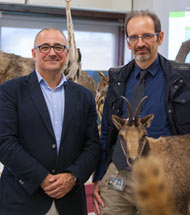Science Museum: new project of the University of Navarra's environmental commitment.
It gathers almost half a century of research on Navarre's biodiversity and houses 25 million specimens of 10,000 species.

PHOTO: Manuel Castells
-
Download the institutional video of the Science Museum of the University of Navarra (wetransfer)
-
Download the infographic of the Science Museum in jpg, pdf and editable pdf (wetransfer)
As part of its Horizon 2020 strategy, the University of Navarra is giving new impetus to its commitment to the environment with the creation of the Science Museum. This project gathers almost half a century of research on the biodiversity of Navarra, especially, and has given rise to a collection of 25 million specimens, one million museum records and more than 10,000 species of animals and plants.
In addition, the Museum conserves almost 16,000 specimens from 11 private donations, including the Lecároz Collection, donated by the Capuchins' high school in 1995; the José del Río Collection, with more than 3,500 shells and mollusks from all the seas of the planet; the Díaz de Cerio and José Luis Nagore Collection, with hundreds of boxes of butterflies and tropical insects; and the Manuel Marten Collection, with 1,400 rocks, minerals and fossils, among others.
It also includes more than 100,000 sheets of plants from the Pamp Herbarium, which was started in the 1980s from collections for research and which represents one of the largest documented collections of plants in Navarra. All these collections constitute a heritage of biodiversity that the University of Navarra wants to make public for the citizens and that make the Science Museum the Spanish university museum with the largest collection, only behind the Museum of Natural Sciences of Madrid.
A Museum that educates, researches and communicates scienceAt present, a small part of its collection is exhibited to the public at Sciences Building (Hexagon Building). There are more than 7,000 specimens of mollusks, insects, fossils, minerals, reptiles, fish and mammals, visited annually by 2,000 schoolchildren from Navarre. In addition, a thousand students from high school diploma knowledge dissemination scientific activities during Science and Technology Week, the celebration of Women and Girls in Science Day or World Environment Day, when part of its collections are taken to the streets of the city.
In this context, the new project wants to promote playful-scientific activities, didactic and experimental workshops, conferences, conference -at partnership with other Schools such as Communication or Architecture- and develop specific educational materials to transmit -especially to children and adolescents- the values of nature conservation and the defense of biodiversity.
On the other hand, the Science Museum has a long history of research and conservation of more than 200 series subject -as the new species described for the first time for science are known-, and of numerous works on climate change and biological evolution. In addition, this entity is part of the world's largest biodiversity information network , GBIF, where it is the Spanish node that supplies more data . This species conservation allows it to safeguard information on species that may be in danger of extinction, and from which their DNA can be extracted so that one day they can recover.
Precisely this week, next Friday, May 18, on the occasion of World Museum Day, its collections will remain open to the public through guided visits to position by researchers and technicians, who will explain to the attendees how each of the specimens are handled, documented, archived and preserved when they arrive at the Museum.
